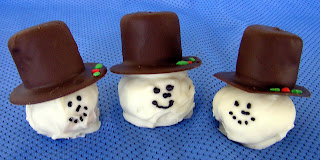
I discovered a quick and easy treat that I quickly whipped up for the holidays. These Marbled Chocolate Treats take only ten minutes to prepare and are delicious to nibble on. Marbled Chocolate Treats have a crunchy texture with a rich chocolate topping. My Marbles Chocolate Treat recipe makes eighteen treats.
Marbled Chocolate Treats
1 pkg Honey Graham Crackers
6 squares Baking Chocolate
½ c peanut butter (I used crunchy)
3 squares White Baking Chocolate
Line a 9 x 13 baking dish with tinfoil extending over the sides. Arrange graham crackers on the bottom until completely covering. Microwave the peanut butter and six squares of baking chocolate until melted (about 1-2 minutes). Stir until well blended then pour over the graham crackers spreading with a spatula until completely covered. Melt the white chocolate and drizzle over the top of the dark chocolate. Cut through the chocolate mixture with a knife to make a marbled effect. Refrigerate for one hour until firm. Turn over and let the chocolate come to room temperature before cutting along the graham cracker lines. Store the treats in an airtight container!

For the last couple of Christmas holidays my daughter, Dawn, has made adorable snowmen that you can eat. These eye-catching treats are irresistible to kids and adults alike. With a soft marshmallow hat covered in chocolate combined with a chocolate covered mild peanut butter head these Winter Snowmen treats will disappear fast. This recipe of Winter Snowmen takes about a half an hour to prepare and makes twelve snowmen.
Winter Snowmen
Snowmen Hats:
12 large marshmallows
6 squares of Baking Chocolate
Toothpicks
wax paper
candy leaves and berry sprinkles
Insert a toothpick on either side of a large marshmallow, dip into melted chocolate until well covered, and place on wax paper. Slowly swirl the marshmallow on the wax paper until you make a half-inch puddle of chocolate in a circle half an inch larger than the marshmallow. Center the marshmallow and take out the toothpicks. Decorate hat brims with candy leaves and berry sprinkles. Let cool and harden.
Snowmen heads:
1 c peanut butter (creamy)
½ c marshmallow cream
½ c powdered sugar
Mix together thoroughly until the consistency is dry yet clumps together. Add more powdered sugar if the dough is too sticky or more peanut butter if your dough won’t stick. Shape into inch size balls.
Melt in a microwave six squares of white chocolate until melted and dip the heads into the melted chocolate with a spoon until covered. Place on wax paper and let cool until hardened.
Use a small amount of melted chocolate (either flavor) to glue the hats and snowmen heads together. Decorate the snowmen’s faces with chocolate icing or black gel to make eyes, nose, and a smiley mouth. Store snowmen in an airtight container!
Weekly tip: A holiday tip to help speed up your meal serving time: place food into serving bowls and cover with saran wrap with the serving utensil as soon as they are prepared. Cold dishes can be refrigerated until time to sit on the table while hot dishes can be kept warm on the stove or in the microwave. When ready to serve your meal it will take only a couple of seconds to transfer your dishes to the table!
Dorcas Annette Walker is a freelance writer, author, columnist, and photographer from Jamestown, TN. If you have any cooking tips or favorite recipes you are welcome to contact me by mail at: Dorcas Walker, 929 Wildwood Lane, Jamestown, TN 38556 or email me at: dorcaswalker@twlakes.net For more information about the Walker family and Dorcas’ books check out her website at: www.dorcasannettewalker.com or htpp://dorcasannettewalker.blogspot.com for other Creative Mountain Cookin recipes.


















